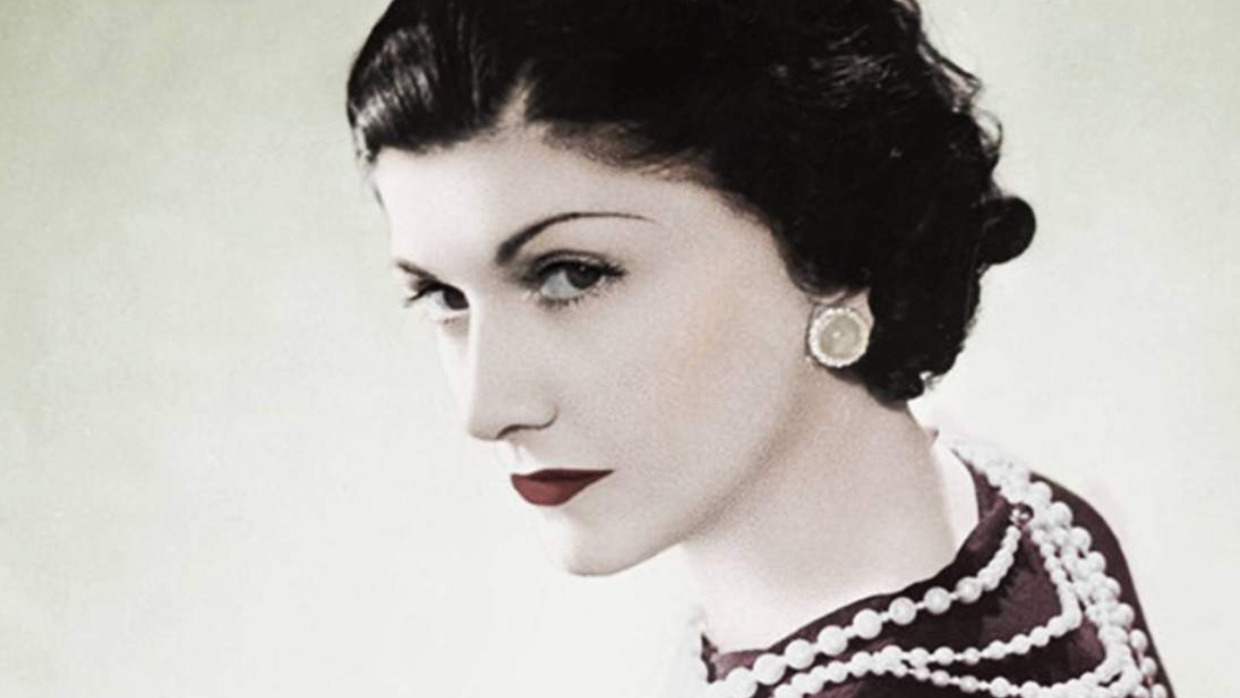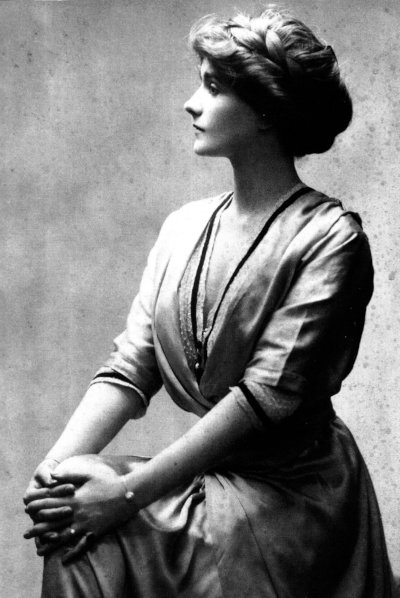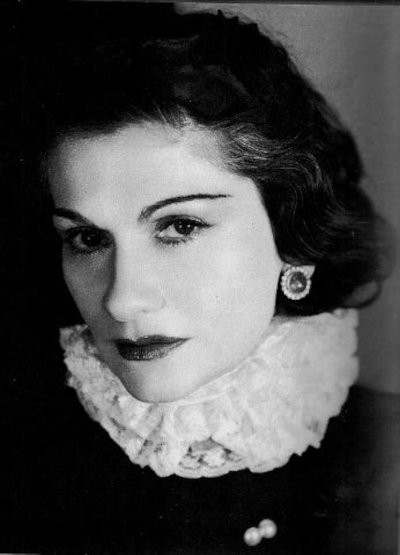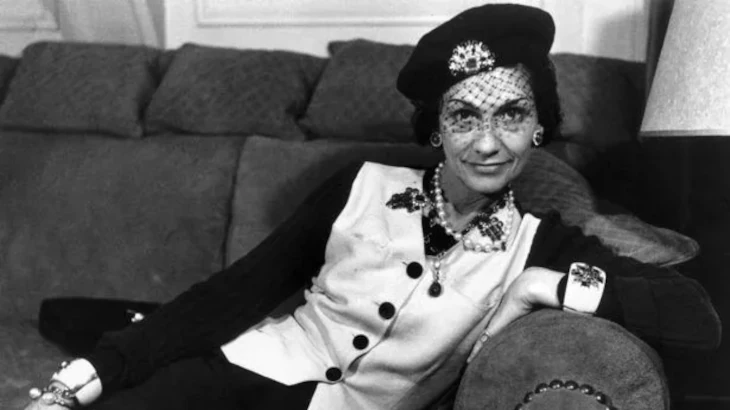 Iran’s Attack on Israel
Iran’s Attack on Israel


12 min read
The famed designer was a vicious anti-Semite and Nazi collaborator.
The new Apple TV series New Look examines the lives and legacies of some of Europe’s most famous couturiers in the years immediately after World War II. Centered on the life of Christian Dior, the series also features French actress Juliette Binoche as Coco Chanel, Dior’s rival and in many ways his opposite.
Perhaps no other fashion designer influenced the way contemporary women dress as much as Chanel. Every woman who counts a “little black dress” as her go-to staple, who wears clothes made of jersey (soft tee shirt material), who believes “less is more” when it comes to fashion, who enjoys wearing large statement pieces of costume jewelry and enjoys wearing sports clothes as daywear owes part of their style to Chanel.
 Coco Chanel, 1909
Coco Chanel, 1909
Coco Chanel revolutionized fashion in 1920s France and Switzerland, and set the tone for women’s fashion for more than the past century. The Chanel company she founded 1921 continues to be one of the world’s most prestigious brands. Yet the image of Coco Chanel has been whitewashed through the years. In reality, she was a zealous Nazi and antisemite who took advantage of World War II to try and steal assets from her Jewish partners – and was possibly a Nazi spy.
Here are a few facts about Coco Chanel: her role in World War II, her odious views about Jews, and the way she was somehow able to charm many people despite her lack of a moral compass.
Coco’s real name was Gabrielle; she was given it by nuns in the free charity hospital where her mother Jeanne gave birth to her, Jeanne being uninterested in naming her. Gabrielle Chanel was the second of six children born into a poor, peripatetic family in the Loire Valley in central France. Her parents married well after her birth; none of their children attended school regularly. Chanel’s brothers grew up barely speaking French; they communicated throughout their lives in their local patois, or dialect. Chanel’s father was an itinerant peddler and the family moved incessantly, usually subsisting in one small, rented room.
Chanel’s mother died when Chanel was 11. Her father hired out Chanel’s younger brothers as farm hands and sent Chanel and her older sister to live in an orphanage for the poor run by a convent in the town of Aubazine. The orphanage, where she lived until she was 18, seemed to be a wonderful haven which Chanel idealized throughout her life.
Chanel marveled at the relative cleanliness of the convent and the relative kindliness of the nuns. She admired their simple black and white clothing and the chains on which they carried their keys and other items. These motifs would shape Chanel’s aesthetic: she loved clear lines, simple colors, and a feeling of crisp efficiency in her clothes. At the convent, Chanel also learned to sew, a skill for which she was eternally grateful.
 Coco Chanel and the Duke of Westminster at the races in 1924.
Coco Chanel and the Duke of Westminster at the races in 1924.
It’s likely that Chanel’s implacable antisemitism also was imbibed in the convent. Biographer Rhonda K. Garelick notes that Chanel entered her Catholic orphanage the year after the Dreyfus trial, in which Albert Dreyfus, a Jewish army captain, was baselessly accused of espionage. The Catholic establishment, on the whole, was fervently anti-Dreyfus, refusing to acknowledge evidence of his innocence. “Seeking scapegoats to blame for their country’s dangerous drift to secularism, many on the Catholic Right identified the usual culprits: Protestants, Freemasons, and especially Jews - whom they accused of inciting the moral decay of France.” (Quoted in Coco Chanel and the Pulse of History by Rhonda K. Garelick: 2014)
After leaving the convent, Chanel was sent to live in a Catholic finishing school in the town of Moulins where there were two types of students: payantes (students who paid tuition) and necessiteuses (those on scholarships). As a necessiteuse, Chanel was forced to wear a plain black dress and perform drudgery around the school. It was a humiliation she never forgot, and a lesson in how important nice clothing – or its lack, can make a person feel.

She eventually opened a small tailoring store in town and began singing in a local cabaret. By all accounts, Chanel was extremely beguiling; Garelick notes “Local residents and former army officers who’d known Chanel as a young woman in Moulins recalled for decades thereafter her exceptional charisma.” Chanel began a series of affairs with wealthy men, using her powers of seduction to significantly increase her social status. She adopted the nickname Coco, either from a popular song she used to sing or else from the French word cocotte, meaning a loose woman. She also began to use the camellia flower – which was associated with prostitutes at the time in France – in her sartorial designs. It was to become a motif that still appears on many Chanel outfits.
Chanel’s sister Julia had a child out of wedlock and later took her own life. After this tragedy, Chanel adopted her nephew, Andre. All her life, rumors swirled that in fact, Andre was Chanel’s own son, and she concocted a story about him belonging to Julia in order to save her own reputation. It was a mystery that was never solved.
While being supported by a succession of men, Chanel also took steps to become financially independent, qualifying as a milliner. She persuaded two of her lovers to give her the financial backing to begin selling her hats in Paris. Chanel sported an insouciant, informal style that made her seem cutting edge and fresh among women still wearing stuffy, corseted dresses. Former Harper’s Bazaar fashion editor Justine Picardie notes that Chanel’s hats – indeed, her entire style – were revolutionary.
Moving to the Normandy resort of Deauville with yet another man, Chanel opened her own boutique in 1913. It reflected her own unusual style at the time: casual and sporty, Chanel’s clothes appealed to younger women who enjoyed sports such as tennis, golf, and swimming. She used the soft cotton fabric jersey to make women’s clothes, something that had not been done before, and incorporated practical elements such as loose waists and pockets into her designs. As more and more women shed their mothers’ and grandmothers’ tight corsets and restrictive clothing, Chanel’s designs were a breath of fresh air. Flappers – young women with short hair and simple clothes –loved her designs. She soon opened more stores in France and Switzerland, spreading her signature style and becoming one of France’s most famous fashion influencers.
In 1920, Chanel realized that adding a perfume to her growing brand would help cement her as a major player in France’s fashion world. She turned to a young perfume maker named Ernest Beaux who was embracing new technology, allowing modern perfumes to be much more complex than previous scents and to last longer. Beaux had been working on updating a storied old scent, called Bouquet de Catherine, which supposedly had its roots among the Medici family in the Renaissance. The story of Chanel’s signature scent’s origin was deliberately obscured in order to create more mystery about it, but it seems that Beaux presented Chanel with several versions he was working on and she preferred number 5. (Chanel was also superstitious and presented her collections on the 5th of May each year.)
Chanel No. 5 was a hit, but the small quantities that she and Beaux created limited its reach. The owner of Galeries Lafayette, Paris’ largest and most famous department store, promised Chanel that he would carry her perfume if she could produce it in industrial quantities. He had just the business partners for her, he said, and introduced Chanel to Pierre and Paul Wertheimer. The Wertheimers owned Bourjois perfumeries, France's largest cosmetics company at the time. They were also Jews. Despite her intense – and by some accounts growing –antisemitism, Chanel had no qualms about entering into business with the Wertheimers if it could make her more money and spread her fame.
The Wertheimers agreed to take over all aspects of the financing, business, manufacturing, marketing and distributing of Chanel No. 5. Chanel is said to have declared, “Form a company if you like, but I’m not interested in getting involved in your business…I’ll be content with 10 percent of the stock.” (Quoted in Coco Chanel: An Intimate Life by Lisa Chaney: 2011) She later disputed that remark. The Wertheimers and Chanel created a company called Parfums Chanel, of which Chanel owned 10%.
In the 1930s, Chanel attached herself to yet another lover, Hans Gunther von Dincklage, an aristocratic German diplomat. In time, von Dincklage embraced the Nazi cause, as did Chanel. The couple traded on von Dincklage’s connections with up and coming Nazis who were solidifying their grip on Germany. Chanel lived in the luxurious Ritz hotel in central Paris, enjoying the life of aristocratic parties to which von Dincklage took her.
In 1939, all French couturiers closed down, including Chanel’s. Though some designers did reopen during World War II, Chanel never did. Instead, she channeled her energies into socializing and partying with senior Nazis.
After Germany invaded France in 1940, the Nazis requisitioned the Ritz to house senior Nazi officers. The new Nazi rulers of Paris offered Chanel the chance to continue living in the luxurious hotel, and she gladly assented. It was a charged decision: by remaining in the Ritz – and socializing with the Nazis living there – Chanel was broadcasting to all of occupied France exactly where her loyalties lay.
Recently, as more materials have become declassified, it’s become apparent that Chanel didn’t only tolerate the Nazis, she actively worked to help them. At the beginning of World War II, Chanel’s nephew Andre fought with France’s army and was taken prisoner in Germany. In 1941, it seems that Chanel offered her services to the Nazis in exchange for Andre’s release. Historian Hal Vaughan describes recently declassified documents which “describe how Chanel and…Baron Louis de Vaufreland Piscatory (another aristocratic Nazi spy) were recruited and linked together…to travel together in the summer of 1941 on an espionage mission for German military intelligence. Vaufreland’s job was to identify men and women who could be recruited, or coerced, into spying for Nazi Germany. Chanel, who knew Sir Samuel Hoare, the British ambassador to Spain…was there to provide cover for Vaufreland’s work.” (Quoted in Sleeping With the Enemy: Coco Chanel’s Secret War by Hal Vaughan: 2012)
Andre was released. In 1944, Chanel undertook a second espionage trip to Madrid. Later that year, after the liberation of Paris, Chanel was arrested and charged with being a collaborator. She was later released; historians speculate that some of her politically connected friends in the Allied countries intervened to help her escape punishment.
In 1941, while ensconced in the Nazi-controlled Ritz, Chanel decided to use the Nazis’ anti-Jewish laws to her advantage. She enlisted the help of her senior Nazis friends to seize control of the 70% of the company Parfums Chanel she’d created with Paul and Pierre Wertheimer. The Nazis were more than happy to comply, but they found out that the Wertheimers had outwitted them.
Before the outbreak of war, sensing that the situation for Jews was deteriorating badly in Europe, Pierre and Paul fled to New York. They set up an entirely new company and produced Chanel No. 5 in a factory in New Jersey. Back in France, the company Parfums Chanel still existed – but the Wertheimers had sold that company to a Christian French businessman named Felix Amiot for 50 million francs. As an Aryan, Amiot had every right to do business under Nazi law; Chanel’s attempts to steal Parfum Chanel were thwarted. After World War II concluded, the Wertheimers bought Parfums Chanel back from Felix Amiot.
In 1954, at the age of 71 and after years of exile in Switzerland, Chanel announced that she was opening a couture house in Paris once again. What was kept secret at the time was the financing which Chanel required to get her new business off the ground.

During the depths of winter in 1954, Chanel and her niece discreetly traveled to New York together to meet Pierre Wertheimer. Pierre’s business had flourished in America and he was a wealthy man, still manufacturing Chanel No. 5 as well as other scents. Chanel asked him for money to launch her brand in Paris again. Pierre agreed to an unusual business arrangement: he bought the entirety of Chanel’s business, including the right to use the name Coco Chanel. In return, he would pay for all of Chanel’s expenses: both all business expenses her new couture house would incur, and also her personal expenses, which were considerable. Chanel had resumed living in the Ritz, and enjoyed entertaining lavishly. With Pierre Wertheimer paying her bills, Chanel never had to worry about money again, and lived comfortably to the age of 87.
Chanel’s styles in the 1950s and 1960s weren’t as cutting edge and popular as her fashions had been in the 1920s, yet Chanel resumed her place in the forefront of French fashion. Jackie Kennedy bought some Chanel suits, and was wearing one on November 22, 1963, when Pres. Kennedy was assassinated, cementing Chanel’s iconic suit in the public eye, though in tragic circumstances.
Today, the brand Chanel is most associated with the designs of Karl Lagerfeld who was the company’s Creative Director from 1983 to 2019. Flamboyant and sometimes outlandish, Karl Lagerfeld helped the brand Chanel move on from Coco’s antisemitism and imprinted it with his own brand of glamor. Lagerfeld counted many Jews among his friends, and even helped fund a synagogue in France that was founded by Holocaust survivors.
Chanel continues to be a privately held company, owned by the Wertheimer family. In recent months, Chanel has shown its support for Israel, pledging to donate $4 million to humanitarian relief in Israel following Hamas murderous rampage on October 7, 2023.
Few consumers realize the intense Jew-hatred, attempted double-crosses, and extreme dramas behind this iconic French brand.

As usual the religious groups create the seeds of hate.
I loved her style since age 13. Now 82. The perfume number 5 is my go to favorite.
Reading this I had the urge to dump my number 5. But then as I read to the end I’ll proudly weta my number5 and be glad for Jewish ownership.
Now about that other big French cosmetic brand? Not our beloved Este
I looked up Este Lauder, and found that she and her family are American Jews. Her son is the CEO of AJC.
Hope none of us buy the toilet water they produce or the books of the scrawny Kenyan Hitler, whose hate for the Eternal Nation pushed him to seek the final nuclear solution to the "Jewish Question" through the terror state of Iran . . .
This was all a very long time ago and, as stated in the article, the company has been owned by Jews for many decades, its artistic director Karl Lagerfeld funded a synagogue, and its CEO is Jewish and the firm contributed 4 million dollars to Israel post October 7. It’s beyond horrific that the origins were so terrible, but every penny spent at Chanel now benefits Jews and Israel. I only wish I had enough pennies to buy something from them, because it would be a direct rebuttal to Coco. Am Yisrael Chai.
i knew most of this, except for how werthheimer financed her post war. he should not have agreed & the writer doesn’t seem to have any problem with this. why didn’t he kick her to the curb when she came begging? what did he think she was doing in nazi paris? crocheting doilies for the resistance? integrity matters.
i didn’t care for the subtle slut shaming regarding her many lovers. it felt like the writer was drawing a connection between her jew hate & her love life. isn’t it enough that she was a nazi without having to make her out as whore? she used men for security & business success, just as men used her to inflate their egos.
too bad the french didn’t hang her for being a traitor, tho they’re hardly known for their courage of conviction.
Thanks for this comment. As the owner of Chanel perfumes, Pierre Wertheimer was invested in helping Coco Chanel rehabilitate her image. As for the slut-shaming, that's a fair point. Chanel was a cocotte at a time and place when that was a legitimate social position. I think my disgust at her lack of morality colored my writing about her. The several biographies I cited in this article paint a much fuller picture of the details of Chanel's life, including her (copious) love life. She comes across as a cold, calculating, and frankly hateful woman - though she must have been incredibly charming to men.
thanks for replying 😀
Justice has been served on Jew-hating France with the growth of the Jew-hating Prevalent Jew-hating Islamists population numbering between 6-7 million. The problems facing France and all of Europe is evident for all to see.
How long before the USA, Canada, Australia and New Zealand wake up from this nightmare .
The Jews have overstayed their time here.
Funny when we see the woke universities in USA ,and ,on the other side, the peoples demonstrating with nazi flags ( 'the good peoples ' as Donald said')
So what’s the point of this article? The current management is not anti-semitic. Are you encouraging a boycott, for something that happened 80 years ago? God said to forgive the Egyptians for slavery after two generations. Fighting over ancient history leads to senseless killings and brutality like October 7. Learn from the past, but don’t relive it.
It sets the record straight. For those who enjoy history for it’s own sake, this is a valuable article.
how very interesting and how nice to know that Coco Chanel did not succeed in stealing from theJews. I loved this article, and while I do not own any Chanel originals, I will remember it when buying perfume. AM YISRAEL HAY. the support for Israel after 10/7 is a nice "payback" for all the hatred.
Remember also Henry Ford before to buy a new car.